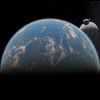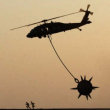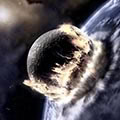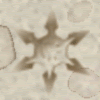|
SpaceEngine TODO List - Updated 14th Dec 2015
|
|
| SpaceEngineer | Date: Friday, 06.05.2011, 17:08 | Message # 1 |
 Author of Space Engine
Group: Administrators
 Russian Federation
Russian Federation
Messages: 4800
Status: Offline
| This is my global TODO list for SpaceEngine, it is primarily concerned with the graphical development of the engine, with gameplay being the least important at this time. Perfecting the engine is my first priority. As shown below, I have organised each section into priority lists. For example, under the section heading 'Engine,' my priorites are in 'top down' order, with obviously the top ones being my highest priority and the bottom ones my lowest concern. This same rule applies to the other section headings for galaxy, nebulae, stars and planets.
Anyway, I should note: as long as SE is a scientifically accurate Universe simulator, then one day it will implement ALL space objects and phenomenon that are known to modern astronomy (if this would be possible to implement on the personal computers). So you may not bother yourself with questions like "will SE one day have meteor rain implemented". I guarantee that it WILL.
Color guide:- Implemented in current version
- Implemented in next version
- Partially implemented
- Uncertain if possible
- Planned
Engine:
- Deferred shading
- Shadow maps
- Ambient occlusion
- Global illumination
- Reverse depth buffer
- Environment map lighting, reflections, refractions
- On-screen motion blur
- Loading of models with animations (spaceships)
- Networking
- Camera control and physics (including the orbital motion of bodies) in a parallel thread
- Recording of flight, its editing and smoothing
- Displays the names of objects on the planetary surface (sea, mountains, craters, etc.)
- Unicode fonts
- Empowering the planetarium (the constellation - the figures, boundaries and names, astronomical coordinate grid, control of the telescope)
- Multi-monitor support, customizable "warper" to create video walls (including fish eye view)
- Network synchronization for distributed videowall rendering
- In the editor: importing of textures, catalogs and models, exporting of procedural textures, catalogs and models (content sharing with other programs and games)
- Eliminating the crashes
- Anti-aliasing
- Proper auto exposure, the real brightness of the surface of planets and stars
- Scripts for the autopilot
- The galactic map, star map, map of the planetary system, a map of the planet
- Built-in editor of planets, galaxies, etc.
- Improved interface and control system (control panel, prompts, Bind keys, etc.)
- Different materials on the same models / textures (metal, glass, etc.)
- Loading/generating resources in a parallel thread
- Localization to other languages
Galaxies:
- Unique procedural model for each galaxy
- Models of irregular and colliding galaxies
- Complex rendering of spiral galaxies (bulge as precomputed texture + disk as sprites)
- A closed universe or a universe with a domain structure
- Embedding of giant nebulae sprite models into the galaxy disc sprite model
- Adaptive level of detail of galaxy sprite model
- Render the galaxy by ray tracing
- Correct blending of dust with the stars (ray tracing or multipass)
- Animation or simulation of galaxy rotation
- Simulation of collision of galaxies
- Modeling the evolution of galaxies
- Correct rendering of dust sprites (extinction effect)
- Procedural large-scale distribution of galaxies (clusters, filaments, walls and voids)
Nebulae:
- Unique procedural model for each nebula
- Animation of accretion disks and jets
- Complex rendering (subsystems with independent LODs)
- Lighting from any number of stars
- Animation of light wave (light echo)
- Animation of expanding shells of supernova and planetary nebulae
- Render the nebula by ray tracing
- Correct blending with the galaxy (ray tracing)
- Correct blending with the stars (ray tracing or multipass)
- Modeling of evolution of diffuse nebulae: its collapse and the formation of star clusters
- Correct rendering of dust sprites (extinction effect)
Stars:
- Tidal distortion of shape, filling the Roche limit (taking into account the ellipticity of orbits)
- Animation of flowing substance, accretion disks and jets
- Quasars with accretion disk
- Neutron stars and pulsars with the animated jets, embedding it into the nebula model
- Stars velocities in the galaxy (needed for ship's hyperflight physics)
- Animation of surface
- Semi-transparent red giants and protostars with animation
- Magnetic activity
- Catalog of binary and multiple stars
- Binary file format for star catalog with built-in octree
- Compilation of a text script catalog into a binary catalog
- Embedding a star catalog in the galactic procedural stars octree
- Dynamic loading of stars catalog from the disk (supporting of unlimited number of stars)
- Variable stars, supernovae
- Catalog of variable stars
- The stars floating in the intergalactic space
- Prominences, flares, clouds (in the form of magnetic field lines)
- Motion of stars in the galaxy
- Modeling of evolution of stars
- Correct dynamic lens flare effect
- Black holes with the effect of the distortion of light rays, Kerr black holes
- Super-massive black holes in galactic center, modeling or animation of motion of nearby stars
- Triple and multiple systems
- Distortion of the shape of the fast rotating stars, gravity darkening effect
- Procedural animated stellar coronae
Planets:
- Decrease of loading/generation time
- Improving the level of detail, reaching of 1 mm per pixel detail
- Lighting of planets with quasar, galactic core, clusters and nebulae
- Distortion function for elevation map (terraces, horizontal shift)
- Modeling of continents
- Illumination of planets with globular clusters, galactic core, close nebulae, supernovae
- Self-shadowing of the terrain, ambient occlusion, global illumination
- Animation of clouds, cyclones
- Clouds shadows on the landscape
- 3D clouds with lighting and self-shadowing
- God-Rays from the landscapes and clouds in the atmosphere
- 3D water with waves animation, simulation of the tides
- Refraction and reflection on the water surface
- More types of atmospheres, generation of models at run-time, binding to astrophysics
- Volcanoes, volcanic eruption, animation of explosions and ash clouds
- Glowing lava flow animation
- Magnetic field modelling
- Lighting of the planetary surface with aurora
- Dust and the asteroid belts around stars and planets (rings), animation, or simulation of the motion
- The shadows of the satellites and other planets on rings and vice versa; volumetric shadows inside the dust rings and self-shadowing of the rings
- Illumination of a planet and satellites by the rings
- Improving gas giant atmospheres
- Surface components (stones, plants, roads, buildings)
- Terramorphing
- Landscape with water and thermal erosion
- Tectonic plates
- Modeling of asteroids collisions with lighting, explosion and the formation of the crater
- Animation of meteorites and meteor rains
- Holes in the surface (caves, mines)
- Right cone of the shadow of the eclipse from moons and rings in the atmosphere
- Refraction in the atmosphere (up to the "bow-tie world")
- Weather conditions (rain, snow, fog, lightning, rainbow)
- Seasonal changes (snow cover and polar caps, dust storms, evaporation or freezing of the seas and the atmosphere)
- Climate and surface generation of "lying on its side" planets (like Uranus)
- The planets floating in the interstellar space (planemo)
- Modeling of 2D gas dynamics of the atmosphere on the GPU
- Modeling the tectonics and evolution of planets
- Simulation of the collision, tidal or artificial destruction of the planets, formation of the asteroid belt and the dust disk around the sun, its further evolution
- Modeling the evolution of the planetary system when the sun goes in the red giant phase
- Simulation of destruction of the planetary system in a supernova explosion
- Improved modeling of the structure of the planetary system, taking into account migration of the planets, resonances, high ellipticity and inclination of orbits
- Different types of clouds, multiple layers
- New classes of planets, binding to astrophysics, geology and geochemistry
- New classes of surfaces
- Linear and radial structures (rivers, grooves, scarps)
- Checking of collisions with the surface
- Fixing of bugs with ellipsoidal planets
- Asteroid belts and comet clouds
- Underwater World
- Different types of hydrosphere (water, methane, lava sea, etc.)
- Different types of terrain in different places
- Animated aurora
- Asteroids
- Comets with an animated tail
- Evaporating planets with an animated tail
- Planets, tidal locked to their suns
- Ocean worlds
- Ice worlds with hydrocarbons oceans (titans)
- Brown dwarfs
- Lights of the night side (hot planets, lava, cities)
Gameplay:
- Server database (work in progress)
- Network system
- Spaceship builder with physical testing of construction
- Cockpit devices: orbital transfer calculator, hyperflight calculator, programmable autopilot, etc.
- Docking system, remote control of units
- Economics, harvesting of resources, refueling, building, etc
- Weapons, combat system
- Giant alien astroengineering constructions
- Destruction of spaceships and buildings (modelling of thousands of fragments on the GPU), animation of explosions (gas dynamics simulation on GPU(?))
- Advanced physics: jet propulsion, aerodynamics and hydrodynamics
- Procedural life
- Procedural civilizations
- Local database
- Loading of models (spaceships, buildings, etc.)
- Internal structure of ships and buildings (indoor-engine)
- Physics: collision detection, newtonian mechanics
- Space physics: gravity forces, orbital flight, hyperdrive
[LIST UPDATED ON 14 December 2015]

|
| |
| |
| Dwarden | Date: Saturday, 07.05.2011, 15:08 | Message # 2 |
 Astronaut
Group: SE team
 Czech Republic
Czech Republic
Messages: 63
Status: Offline
| good list, i will read it thru if i spot anything You forgot 
Ideas are like ocean w/o borders! https://twitter.com/FoltynD
|
| |
| |
| j0KeR | Date: Saturday, 07.05.2011, 19:45 | Message # 3 |
 Explorer
Group: Users
 Greece
Greece
Messages: 178
Status: Offline
| And what of those that have nothing in the end like "?" ,"!!!" , "!!!!!" , its under construction , you havent decided or what ? 
By the way my opinion "Simulation of destruction of the planetary system in a supernova explosion" , "Water, waves animation (including weather), the simulation of tides " <-- IS A MUST !!  and "Different types of hydrosphere (water, methane, lava sea, etc.) " <-- yes ! especially in gas giants , well of course there are other things that have a priority in your post like "Reducing Lag" and "Eliminate Crashes" but these three in my opinion should be next and "Different types of hydrosphere (water, methane, lava sea, etc.) " <-- yes ! especially in gas giants , well of course there are other things that have a priority in your post like "Reducing Lag" and "Eliminate Crashes" but these three in my opinion should be next 
"Novus Ordo Seclorum"
Intel Core(E6850) 2 Duo 3.00 GHz \ Geforce GTX560 1024MB \ 4GB 667(MHz) 2 Channel RAM \ Windows 7 (32bit) \ Samsung SA700D 120hz (3D)
|
| |
| |
| SpaceEngineer | Date: Sunday, 08.05.2011, 17:01 | Message # 4 |
 Author of Space Engine
Group: Administrators
 Russian Federation
Russian Federation
Messages: 4800
Status: Offline
| The notes marked by (!!!!!) is my first priority, which must be done in recent releases, (!!!) is second priority. (?) is probably unnecessary or impossible features.
*

|
| |
| |
| Banquet | Date: Saturday, 14.05.2011, 19:33 | Message # 5 |
|
Observer
Group: Newbies
 United Kingdom
United Kingdom
Messages: 1
Status: Offline
| That's a great toto list! My personal favourite for being added to the sim would be newtonian physics and being able to orbit planets ala Orbiter - but with the assistance of an autopilot because I find orbiter a little too difficult. Some like the old microsoft space simulator! Space Engine is a fantastic program - my admiration and gratitude to the programmer  PS, how many security codes to we need to go through to post here... I need to complete one to register, another to access the registration link - another to finish the registration, another to log into the forum and it looks like I'm going to have to do another one to complete this post!!!!
|
| |
| |
| Neon | Date: Saturday, 14.05.2011, 21:57 | Message # 6 |
|
Explorer
Group: SE team
 Australia
Australia
Messages: 208
Status: Offline
| Love the list... I too hope the orbital mechanics have an autopilot, or
at least something a little easier than Orbiter. One thing I'm really looking forward to is a finding the answer to a question
I've long wondered. That is in Interstellar travel over long distances,
what effect Orbital Mechanics have over the length of the journey. I'm
hoping SE will answer that for me.  As for ships, definitely hoping it's not going to be like Celestia's ships, just
a model, but really has some mass and thrust abilities at the very least,
and some means to display relevant orbital information, and ways of
planning out Hohman Transfer orbits.
|
| |
| |
| SpaceEngineer | Date: Sunday, 15.05.2011, 00:22 | Message # 7 |
 Author of Space Engine
Group: Administrators
 Russian Federation
Russian Federation
Messages: 4800
Status: Offline
| Banquet, thanks, I will ask administrator to disable some secutrity checks here.
Neon, on Russian forums we have discussion about realistic physics model for the game. Basic gameplay will be similar to Noctis - flying across the Universe, finding habitable planets etc. But here will be orbital mechenics for land-orbit shuttles and slow interplanetary travels, and special physics of interstellar hyperflights, that takes into account the laws of conservation on energy and momentum. "Theory" is still in developing. My goal to develop non-contradictory theory of hyperflights, so it will be impossible to have infinite energy. For example, free falling of ship onto planet and hyprjump back to high altitude, another free falling and hyperjump etc.
I also publish the basic concept of main spaceship on Russian site. Maybe I translate it and write here, if I have some time to do it. The main idea is a big ship with powerful plasma engines and main reactor with heat radiators, meteorite shield on nose, huge radiation shield for crew compartment with no glass windows, and hangars with suborbital shuttles for landing onto planets. All design is realistic, except the hyperdrive:)
Interplanetary travel with Hohman Transfer orbits is very long, and makes no sense if your ship has hyperdrive or 1-10g jet engines. For example, Hohmah flight from Earth to Mars takes 7 months (if I remember correctly). So in the game players will use acceleration of time, or interplanetary flights with constant acceleration mode. For example, traveling to Mars with constant 1g acceleration (halfway to accelerate, halfway to decelerate) takes only 3-4 days. However this is still too long. By the way, I would like to create a multiplayer online game, so it will be impossible for players to use acceleration of time.
So even with a flight to a Moon players can use hyperdrive. But it will be not be easy like in most space sims. You must compensate your velosity relative to planet to that which you want to jump, and take into account your potential energy. To do this, you must use your jet engines and autopilot to calculate acceleration vector. And here orbital physics appear. Of course, orbital physics is also used for orbit-surface-orbit flights.
*

|
| |
| |
| Neon | Date: Sunday, 22.05.2011, 17:24 | Message # 8 |
|
Explorer
Group: SE team
 Australia
Australia
Messages: 208
Status: Offline
| Ahhh thankyou for the detailed answer. That sounds really good,
and something I'm really looking forward to. Looking at SE it just
screams Game.  Yes definitely understand the problems of using coasting space flight, as we
do now. Constant acceleration is really the only real option. Hyperjumps
would be really cool. Of could there's lots of ways it could be implemented
into a game, either through just given the maximum capability at start,
or earn different upgrades. But that's all for much later. For now, I can't tell you how impressed I am with your work. I can
certainly see a bunch of companies knocking on your door for rights
for space games :). Thanks again for the insight 
|
| |
| |
| Tzion | Date: Thursday, 26.05.2011, 08:27 | Message # 9 |
 Observer
Group: Newbies
 United States
United States
Messages: 8
Status: Offline
| Hi, I was flying around and I noticed that the planetary rings in the engine are completely flat. Do you plan on replacing them with polygons (chunks of rock and ice and dust clouds) at some point?
|
| |
| |
| SpaceEngineer | Date: Friday, 27.05.2011, 00:49 | Message # 10 |
 Author of Space Engine
Group: Administrators
 Russian Federation
Russian Federation
Messages: 4800
Status: Offline
| Yes, did I forget to add it to TODO list?  Some type of rock or snow asteroids in rings are planned. But as we know, Saturn's rings consist mainly of ice dust. Usual thinking of rings composed of huge rocks is incorrect. Big rocks must collide with each other and shred into smaller concretion; grains and dust. So rock-composed rings must be tenuous, to look like asteroid rings. The distances between asteroids is thousand and millions times greater than the size of asteroids. Some type of rock or snow asteroids in rings are planned. But as we know, Saturn's rings consist mainly of ice dust. Usual thinking of rings composed of huge rocks is incorrect. Big rocks must collide with each other and shred into smaller concretion; grains and dust. So rock-composed rings must be tenuous, to look like asteroid rings. The distances between asteroids is thousand and millions times greater than the size of asteroids.
*

|
| |
| |
| Neon | Date: Friday, 27.05.2011, 01:18 | Message # 11 |
|
Explorer
Group: SE team
 Australia
Australia
Messages: 208
Status: Offline
| Meteors are not the only thing to be afraid of when traveling through
the Interstellar medium. Dust grains are also extremely hazardous
to a ship at any speed greater than 50% speed of light.
Here's a link to Ask the Astronomer site where he explains why this is
so dangerous.
At what speed does the interstellar medium become lethal to high speed flight?
It's all about kinetic energy the old E = 1/2 mv^2 even if m is only a few grams,
when you start adding high velocities, E turns into something nasty that isn't
very healthy for space travel out there between the stars.
Of course, as he says, we really don't know what the Interstellar Medium is like,
if it's full of dust, or clean. Hey, a little danger adds to the excitement 
|
| |
| |
| SpaceEngineer | Date: Friday, 27.05.2011, 01:29 | Message # 12 |
 Author of Space Engine
Group: Administrators
 Russian Federation
Russian Federation
Messages: 4800
Status: Offline
| Neon, are you choosing the correct thread? 
Yeah, the 1 gram grain at 0.99c has kinetic energy of 13 kilotons TNT - it's like Hirosima bomb:)
We know well the matter density in the interstellar medium from astronomical observations. But we don't know the state of it - is it the smallest dust particles or equivalent 1-mm grains.
*

|
| |
| |
| Neon | Date: Friday, 27.05.2011, 16:27 | Message # 13 |
|
Explorer
Group: SE team
 Australia
Australia
Messages: 208
Status: Offline
| hehe yeh... probably not 
We should know when Voyager leaves the heliosphere in a few years, though
they probably don't have much on there to detect dust grains. But I'm sure they
can turn the cameras onto Voyager itself and see if it becomes pitted at all, but
it is travelling quite slow. I'm sure they'll figure something out.
|
| |
| |
| VectorSigma | Date: Wednesday, 15.06.2011, 05:50 | Message # 14 |
 Observer
Group: Newbies
 United States
United States
Messages: 2
Status: Offline
| Quote (SpaceEngineer) Animation or simulation of galaxy rotation
Simulation of collision of galaxies (?)
Modeling the evolution of galaxies (?)
These are possible to do in real-time with modern GPUs, though you would have to temporarily reduce the number of bodies with an estimation algorithm.
N-body problem
Nvidia has OpenCL (as well as Cuda and DirectCompute) code samples:
Nvidia N-body simulation code samples (OpenCL)
|
| |
| |
| Neon | Date: Wednesday, 15.06.2011, 10:28 | Message # 15 |
|
Explorer
Group: SE team
 Australia
Australia
Messages: 208
Status: Offline
| Yes I"m sure you are right, but as I'm sure you're aware, not
everything is on screen at the same time. I don't know... I hope
it's doable. 
|
| |
| |